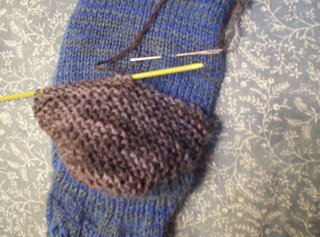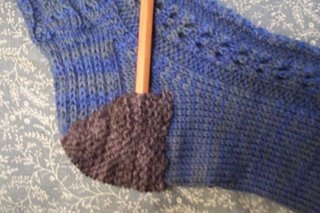To Mend or Not to Mend, (updated)
socks, that is.
In the far off days when I actually got my socks from a store, they always wore out first at the toe. Now that I can control the length of the foot, this is no longer a problem. Instead they always seem to give out right under the heel. (Do I grind my heels when I walk? Or is it just that the knitting is looser where I work back and forth for the heel turn? I suspect the latter.) So what are the options?
a) Retire the socks. Notice I do not say "throw away". There were a few early pairs that did end up as dust rags. But when I have put the time and effort into a nice pair; and more importantly have become attached to them through frequent, close contact; and when 90% of the knitting is still perfectly good; I am not going to throw them away. If they are truly beyond repair, or have been repaired and worn ragged again, I retire them to the "old socks home", which at this point is a nice wooden box my father made me. What my heirs do with this collection when I die is their problem.
b) Cut them off at the ankle, add ribbing to the bottom and turn them into legwarmers. I've done it with a pair of knee socks, and it worked nicely (I'm wearing them at the moment, as a matter of fact.) These are not "fashion statement" legwarmers. They go under my jeans to ward off drafts. The pair in question is shorter, though, and not really a candidate for this treatment.
c) Unravel from the toe and reknit the foot. Or just cut them off at the ankle and reknit the foot, assuming I have more of the same yarn (which I don't) or something reasonably coordinating. This is a lot of work for results that might or might not look like "I meant to do that." Wouldn't I rather just knit a new pair altogether?
d) Darn. Believe me, I've tried. I end up with a misshapen mess. Same goes for Swiss Darning a/k/a duplicate stitch. For smaller holes than this one, maybe, but not here.
e) Carefully cut out the entire heel, pick up stitches and reknit the heel. Are you kidding?
f) Knit patches, which is what I actually intend to do. This will probably offend purists of all stripes. It will transform the socks from modestly elegant to everyday somewhat broken down workhorses. But what the heck, it works for me.
Two little patches. (Hey, that second sock is going to go soon - might as well do both while I'm at it.) I used garter stitch to avoid fighting curly edges when I sew them on. I left long yarn tails for sewing.
First I sewed the shaped lower edge of the patch to the bottom of the heel flap, then I sewed the live stitches off the needle to the foot. I could have bound then off and then sewn them down, but this would have made a thicker and less elastic seam.
At this point there is a little unsewn gap at each side (pencil for demonstration purposes only). I am going to leave it unsewn on the theory that a little more elasticity here will encourage the patch not to rip out.
Final result, not pretty, but I hope servicable. And in our throwaway world, there is something endearing about that. How long will it last? Good question. I hope for a while. At any rate, this pair will know I did what I could to delay the trip to the old socks home.
The Law of Entropy and the First Noble Truth alike remind us that nothing is permanent, but I like to try to keep things going when I can.


3 comments:
What a great solution! Thanks for writing about it.
Phyll
I think it's a brilliant solution, thanks for the idea. My husband wears out the heels in the same way, I vowed I would not make him any more socks (these are his absolute favorites), but now I am rethinking this.
I LOVE this! I haven't been knitting socks long enough to have encountered this problem, but I know it is lurking somewhere in my future. What an elegant (yes, elegant!) solution! Someday, not too soon I hope, I will be employing your method.
btw, I used Google's "define:" function and found this definition of elegant: "human dimensions of effectiveness, such as feelings, emotions and ergonomics, expressed in practice in issues such as usability, simplicity and personal preference." See? Your solution IS elegant.
Post a Comment